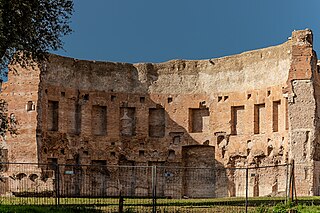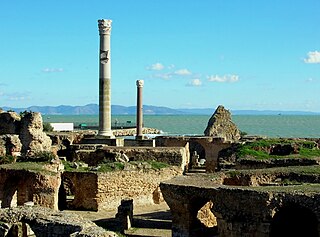 W
WBathing played a major part in ancient Roman culture and society. It was one of the most common daily activities and was practiced across a wide variety of social classes.
 W
WAllianoi, is an ancient spa settlement, with remains dating predominantly from the Roman Empire period located near the city of Bergama in Turkey's İzmir Province. The site is at a distance of 18 kilometers to the northeast of Bergama, on the road to the neighboring town of İvrindi. Allianoi is directly inside the reservoir of the Yortanlı Dam, built by the Turkish State Hydraulic Works. After ongoing discussion in Turkey with regards to preserving Allianoi's ruins, the site was covered with sand and the dam was activated, resulting in Allianoi's complete inundation and destruction in February 2011.
 W
WThe Roman Baths of Ankara are the ruined remains of an ancient Roman bath complex in Ankara, Turkey, which were uncovered by excavations carried out in 1937-1944, and have subsequently been opened to the public as an open-air museum.
 W
WIn ancient Rome, the apodyterium was the primary entry in the public baths, composed of a large changing room with cubicles or shelves where citizens could store clothing and other belongings while bathing. Privately owned slaves, or one hired at the baths, would look after belongings while citizens enjoyed the pleasures of the baths. A contemporary Roman schoolbook quotes a wealthy young Roman schoolboy who entered the baths, leaving his slave behind in the apodyterium: "Do not fall asleep, on account of the thieves". A wealthy person might even bring more than one slave along, as parading one's slaves at the baths was a way to show one's elevated social status. For wealthy free men and women slaves carried the bathing paraphernalia: exercise and bathing garments, sandals, linen towels, and a toilet kit that consisted of anointing oils, perfume, a sponge, and strigils.
 W
WAquae Iasae was the Roman settlement and Roman bath in the area of present city Varaždinske Toplice, Croatia. Today it is the name of the archaeological site.
 W
WIn classical antiquity, a baptisterium was a large basin installed in private or public baths into which bathers could plunge, or even swim about. It is more commonly called natatorium or piscina.
 W
WThe Barbara Baths are a large Roman bath complex in Trier, Germany. It is the largest Roman bath north of the Alps. It is designated as part of the Roman Monuments, Cathedral of St. Peter and Church of Our Lady in Trier UNESCO World Heritage Site. For preservation, the baths are closed to visitors as of 2014.
 W
WThe Baths of Antoninus or Baths of Carthage, located in Carthage, Tunisia, are the largest set of Roman thermae built on the African continent and one of three largest built in the Roman Empire. The baths are also the only remaining Thermae of Carthage that dates back to the Roman Empire's era. The baths were built during the reign of Roman Emperor Antoninus Pius.
 W
WA caldarium was a room with a hot plunge bath, used in a Roman bath complex.
 W
WThe Cross Bath in Bath Street, Bath, Somerset, England is a historic pool for bathing. It was rebuilt, in the style of Robert Adam by Thomas Baldwin around 1789. It is recorded in the National Heritage List for England as a designated Grade I listed building, and was restored during the 1990s by Donald Insall Associates.
 W
WA frigidarium is a large cold pool at the Roman baths. When entering the bath house, one would go through the apodyterium, where they would store their clothes. After the caldarium and the tepidarium, which used hot water to open the pores of the skin, the frigidarium would be reached. The cold water would close the pores opened by the hot water. There would be a small pool of cold water or sometimes a large swimming pool. The water could be also kept cold by using snow.
 W
WHammam Essalihine is an ancient Roman Bath situated in the Aurès Mountains in the El Hamma District in the Khenchela Province of Algeria. As the Latin name suggests, it dates from the time of the Flavian Dynasty.
 W
WThe laconicum was the dry sweating room of the Roman thermae, contiguous to the caldarium or hot room. The name was given to it as being the only form of warm bath that the Spartans admitted. The laconicum was usually a circular room with niches in the axes of the diagonals and was covered by a conical roof with a circular opening at the top, according to Vitruvius, from which a brazen shield is suspended by chains, capable of being so lowered and raised as to regulate the temperature. The walls of the laconicum were plastered with marble stucco and painted blue with gold stars.
 W
WPilae stacks are stacks of pilae tiles, square or round tiles, that were used in Roman times as an element of the underfloor heating system, common in Roman bathhouses, called the hypocaust. The concept of the pilae stacks is that the floor is constructed at an elevated position, allowing air to freely circulate underneath and up, through the hollow bricks, into the structure walls. Examples of such baths are found not only in Rome, but also in distant parts of the Roman Empire such as Roman Britain, or Chellah, in modern-day Morocco.
 W
WThe Roman Thermae are a complex of Ancient Roman baths (thermae) in the Black Sea port city of Varna in northeastern Bulgaria. The Roman Thermae are situated in the southeastern part of the modern city, which under the Roman Empire was known as Odessus. The baths were constructed in the late 2nd century AD and rank as the fourth-largest preserved Roman thermae in Europe and the largest in the Balkans.
 W
WSuspensura is the architectural term given by Vitruvius to piers of square bricks that supported a suspended floor of a Roman bath covering a hypocaust cavity through which the hot air would flow.
 W
WThe tepidarium was the warm (tepidus) bathroom of the Roman baths heated by a hypocaust or underfloor heating system. The speciality of a tepidarium is the pleasant feeling of constant radiant heat which directly affects the human body from the walls and floor.
 W
WIn ancient Rome, thermae and balneae were facilities for bathing. Thermae usually refers to the large imperial bath complexes, while balneae were smaller-scale facilities, public or private, that existed in great numbers throughout Rome.
 W
WThe Trier Imperial Baths are a large Roman bath complex in Trier, Germany. It is designated as part of the Roman Monuments, Cathedral of St. Peter and Church of Our Lady in Trier UNESCO World Heritage Site. It was constructed in the 4th century AD.
 W
WThe Baths of Zeuxippus were popular public baths in the city of Constantinople, the capital of the Byzantine Empire. They were built between 100 and 200, destroyed by the Nika revolt of 532 and then rebuilt several years later. They were so called because they were built upon the site where a Temple of Zeus (Jupiter) had formerly existed. They were built around 500 yards south of the much older baths of Achilles of the earlier Greek Acropolis in Byzantion. The baths were famed primarily for the many statues that were built within, and the famous people they each represented. However, they were later used for military purposes, during the seventh century. Excavations of the site and the Baths were made in 1928.